RiME is a game that I heard a lot about right until its release, and then it seemed to just disappear into the ether after it was finally available. Reviews have been moderately good, with the biggest critique being that RiME takes the best elements from games like ICO, Shadow of the Colossus, Journey, and The Legend of Zelda series and builds on them, rather than innovate on its own.
But doing something well and building on things that came before is hardly a detriment, and it’s certainly not in this case, either. RiME is a lovingly crafted experience, and what it “lacks” in innovation it makes up for in polish, story, and depth.
The Premise
For those of you who have played Journey, the beginning of RiME is familiar enough: a character lands (or in this case, is washed up) on shore, no cutscene plays, no information is given, and then the player has control over the character. What follows is five chapters of puzzles, darkness, light, friendship, loss, and acceptance – but more on that in a bit.
RiME follows a young, nameless boy as he quests across a beautiful island paradise. Much like the player, he seems to be trying to figure out what is going on. Early on, the player might begin to feel like something is not quite right, because no matter what happens, the boy is rarely afraid, as if almost everything he comes across is somehow familiar to him.
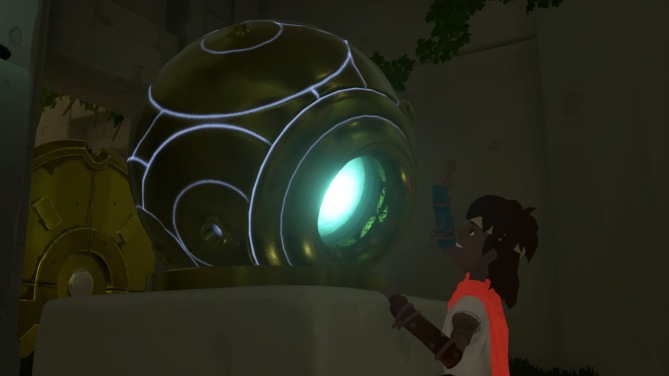
Although the young protagonist never truly leaves the island, he experiences it in different ways, from beautiful lush vistas, to dry, hard deserts, from inside dark caverns to outside in abysmal rains. It’s easy to think that, like stories that have come before, RiME is telling a subtle story that only people who look closely enough will see.
Early on, our protagonist meets and befriends a little fox, who becomes a sort of guide throughout the game, gently hinting where the next important area is, which is nice as the boy often has to stray from the path to solve the games many puzzles. I found myself looking forward to seeing this friend, because, like the Companion Cube in Portal, our little fox friend is really the only companion we have on our otherwise solitary journey through the island.
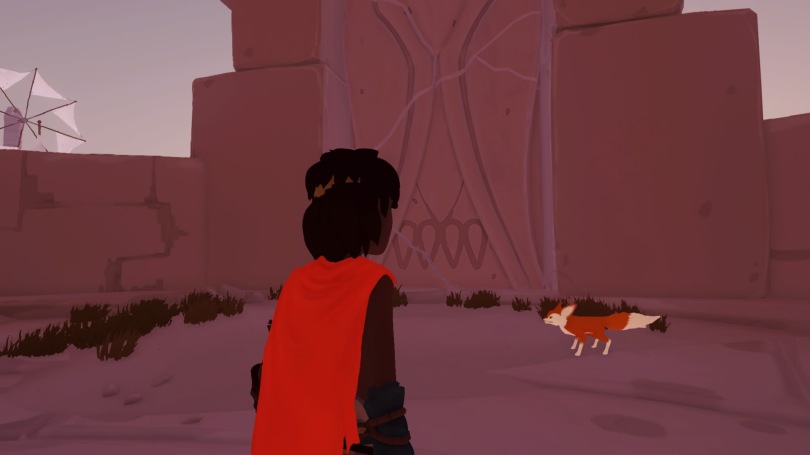
Like reviews have said, I did find myself nodding knowingly at different sections, most often drawing parallels to Journey, but the references were welcome, because RiME does just what the reviewers have said: it takes the best elements of previous games and builds on them. Where the “underground” level in Journey was dangerous, here it was unnerving and depressing, offering a labyrinthine experience that left you – and presumably, the character – wanting to finally be somewhere out of the darkness, not because it was safer, but because you didn’t want to be lost in the dark anymore.
Lost in the dark. That’s an interesting phrase to use for a game, isn’t it?
Overall, the game does a fantastic job of pulling the player into the game world. I usually root for characters in games I play, but there were times when our young protagonist actually seemed frightened and I couldn’t help but feel like it was my responsibility to get him through safely. Suddenly, we were a team, and we were on this journey together, whatever happened.
Learning to Game
Something I mentioned before is that RiME has very little hand-holding by way of controls. It encourages you to press all the buttons to see what they do, and experiment with the environment to find out the rules. While there are a few instances in the beginning to gently prompt (and remind once or twice) a certain action around an important item, overall the game let you learn the rules of the world the old fashioned way: by inhabiting the world.
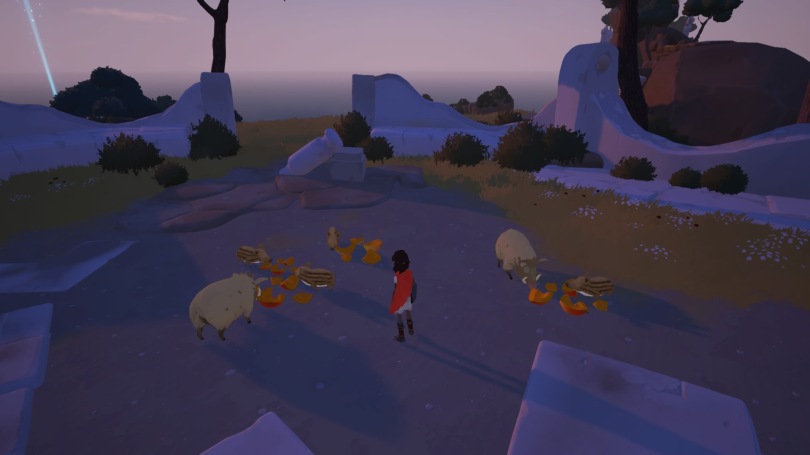
I appreciate when games (or perhaps their developers) take into account what I call “the real gamer,” or the person behind the controller. We all have brains; even if we haven’t played a game before, we are all used to using tools, and that is exactly what a controller is. What do you do with a new tool? Try different things and see what happens.
RiME lets you do just that. You see some little pigs eating fruit on the ground, then notice a fruit tree? Well, go over and push some buttons to see if you can pick some fruit. Need to put it down? Try another button. Oops; you threw it across the field? That’s okay, try again. There was never a point in the game I was left wondering what control to use, because the learning curve was gentle, yet effective, and instruction – when used – was not intrusive.
I put this section under “learning to game” because, to me, it hearkened back to games like Super Mario Bros., which gave no indication about what the controls did, and yet taught you every single rule of the game on the first screen*. Or a game like Mega Man X, which does the same thing all in the first level.
There is, of course, more to this game that first meets the eye, though, and it is well worth exploring.
**Major plot spoilers are below. I highly recommend playing this game for yourself before proceeding, as RiME is best experienced by each person on their own**

Major spoilers to commence in 3… 2… 1…
The Trophies
I don’t usually bother with trophies in games, but the trophies the player earns for each stage of the plot make for a nice segue to the heart and soul of RiME. The trophies are as follows:
Don’t Say No
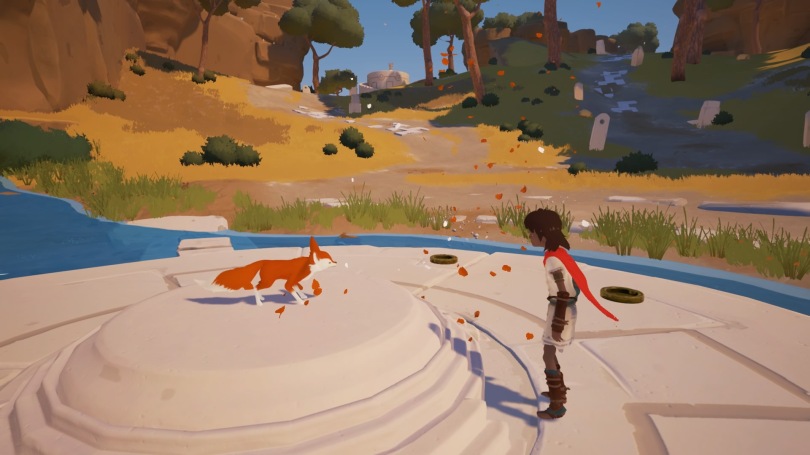
The first of five chapters, this area is bright, cheery, and goes through regular day/night cycles. The water is clear, the sun is shining, and everything is perfect. Absolutely perfect.
Unbearable
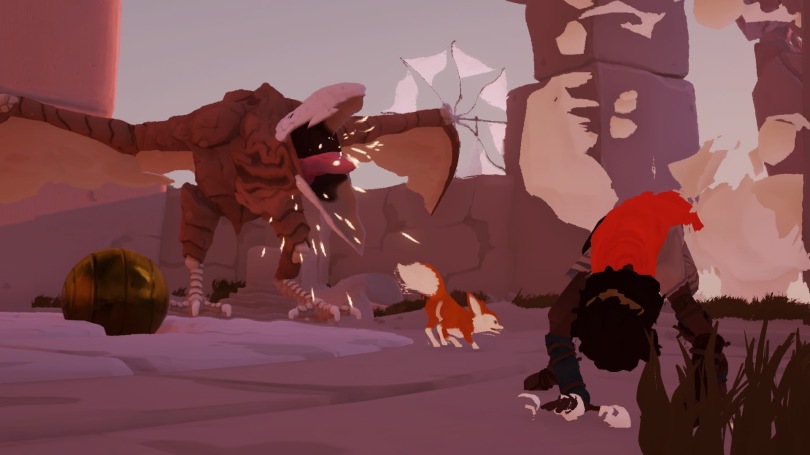
The second stage takes place in a barren version of the first level, with a giant bird of prey hunting our protagonist. Our young hero must run from cover to cover to avoid getting plucked up and swooped off, and every moment spent in the sweltering sun is tense. The final fight between the boy and the bird culminates with the boy finding the bird’s nest, escaping one final chase, and knocking the bird from the sky by creating a dreary, rainy night.
Ask For A Miracle
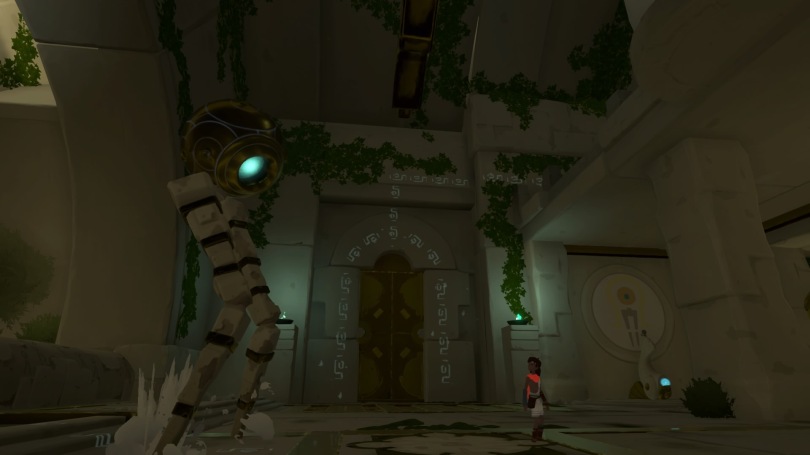
The third stage involves our young hero passing into an overgrown, dark, and abandoned area, surrounded by dark specters that block his path along the way. Some of the puzzles seem to require the help of a gargantuan creature that our hero must find and revive, hidden in the deepest heart of an old temple. After finding this mysterious help, our hero watches as, one by one, the awakened creatures sacrifice themselves so the boy may continue on. It seems that they won’t be able to make the journey with the boy, after all.
No Hope

Dark. Pouring rain. Left alone with nothing but dark specters for company.
To Let Go

The end.
You may have noticed a theme that permeates the above five chapters: they each represent one of the five main stages of grieving. In order, they represent denial, anger, bargaining, depression, and, finally, acceptance. What RiME does well is not hit you over the head with these concepts, but rather gently takes you by the hand and lets you experience each of these stages for yourself.
Learning to Grieve
Although the stages of grief occur during any loss (aka a major, typically undesired, change in a person’s life), people most often talk about the five (sometimes seven) stages of grief when someone is coming to terms with the death of a loved one, or, alternatively in this case, when a person is coming to terms with their own imminent death. These stages can also occur before someone dies, perhaps during the final stages of a terminal illness, when loved ones are preparing themselves for their friend or relative’s passing. They may occur again after the person’s death, and again later.

The point is, unlike how many people are taught, grieving doesn’t really follow a formula. People may pass through the stages of grief many times, sometimes lingering at one stage or another, and sometimes passing over stages altogether.
If you take nothing else from this post, I want you to remember that there is no “right” way to grieve, and certainly no time limit on how long you are “supposed” to grieve for.
Having said that, for the purposes of this article, we’ll be taking a look at the five stages of grieving, which represent the course of emotions and experiences most often felt by people grieving.
Denial is the first stage, and can sometimes be the hardest stage to pass through. This is the time when a person tells themselves that everything is fine, that there is no problem. The sun is shining, the water is warm, the animals are friendly. Nothing is going to harm you, no matter how deeply you swim or how high you climb. Everything is just perfect.

As denial begins to wear off, a person typically will feel a great deal of emotional pain as they realize that reality is not as rosy as they wanted to believe. This pain often turns into anger at the situation that caused the pain. Sometimes, this anger is directed at the person who is dying – how dare they do something that hurts you. Or, for the person dying, this anger could be at themselves, or at a higher power/the world/a disease. This anger is the second stage, and sometimes people stay here for a long time, because the anger hurts them less than sadness. They can even be carried away by it, if it is left unchecked.
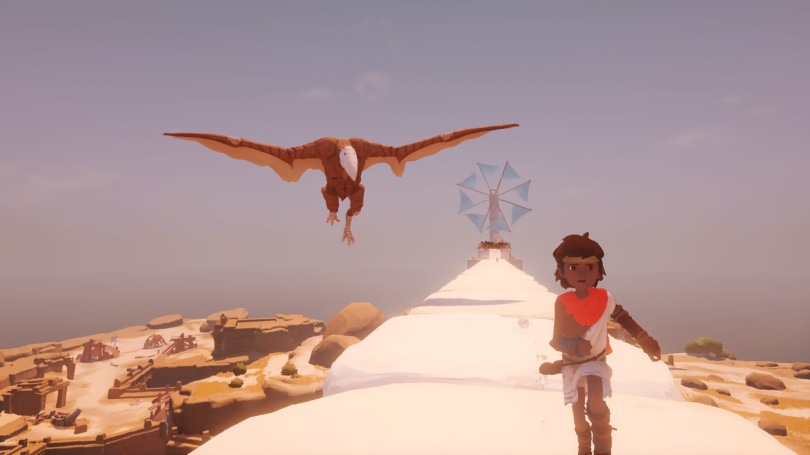
But, as anger fades, the person may begin to feel desperate. Bargaining begins to occur: I’ll do X if my loved one/I will be okay. I’ll never do Y again, as long as Z happens… This asking for a miracle is a last-ditch attempt to stave off the sadness that is still bubbling inside.
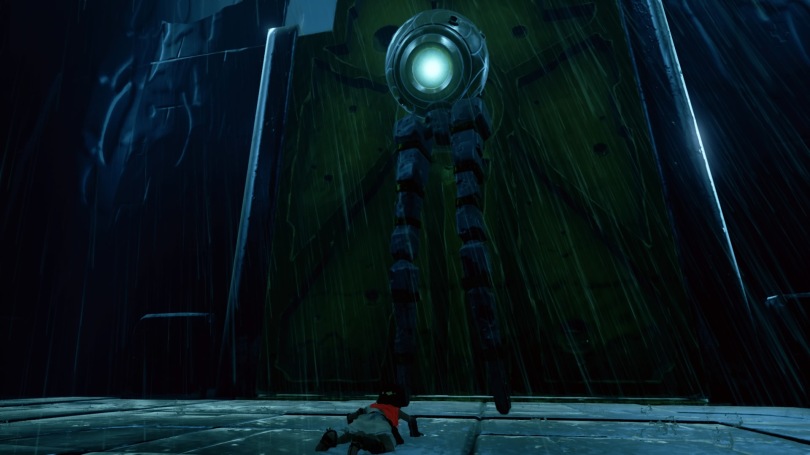
When the bargains fall through, people can fall into a deep sadness or depression. All of the sadness that has been bubbling beneath the surface comes up, no longer shrouded underneath anger, and no longer able to be held off by attempts to keep the difficult event from occurring. This deep sadness may feel never-ending, and as if nothing will ever be right again. They might feel frozen in place, consumed with feelings that feel like they will never end.

Acceptance is the final stage, and can occur in small bits, sometimes by a person creating their “new normal” – if that is the case – or by making peace with their fate in some other way. Unfortunately, this is the hardest stage to enter, as it can be so hard to accept that a loved one is gone, but those that do find acceptance begin to build their new reality around their loss.
It’s that simple.
Not really, of course. In real life, people who reach the acceptance stage can find themselves going through the stages of grieving again, or passing through some stages before landing back on acceptance. And that’s okay.
As a personal example, my father died when I was in high school (read: a long time ago), and that is something that I am able to say I have accepted. However, at the anniversary of his death, or when something happens and I wish he was around, I find myself back in the sad or “depressed” stage, usually bouncing back to anger in the form of resentment at young women who still have fathers who are alive, before ping-ponging into depression again and finally settling back in to acceptance.
And that’s okay.
Everyone is entitled to feel what they feel, and everyone needs to grieve in a way that makes sense to them.
For some, that means following a young boy on his travels with a little fox.
Gaming and Grieving
Earlier I mentioned that I began to feel responsible for our hero’s well-being, especially after the first level was over. Maybe it’s because he was a child, but there was something about seeing him cower in fear that really made me care about him. I really wanted him to be okay, and thus when the game showed him tentatively walking through an area, arm raised a little to protect himself from potential danger, while I – the player – ruthlessly pushed him deeper into the dark, I found myself thinking things like “just a little further,” “it’ll be okay,” and “oh, thank goodness. Little Fox Friend is back with you!”

Watching him make friends with the fox and, later, the large mechanical orbs made me feel good – the game kept teasing me with a figure in a red cloak that the boy kept trying to reach, and so seeing him have others on his side was reassuring in a way.
And all of that started to fall apart in the fourth (depression) stage.
By this point, our hero had acquired a gaggle of mechanical helpers, and we the players had witnessed a heart-wrenching scene of the boy on a boat with the red-cloaked figure during a storm. During this scene, we witnessed a rogue wave crash over the boat, washing the red-cloaked figure out to sea even as the boy tries to grab him, ripping part of his cloak off in the process.
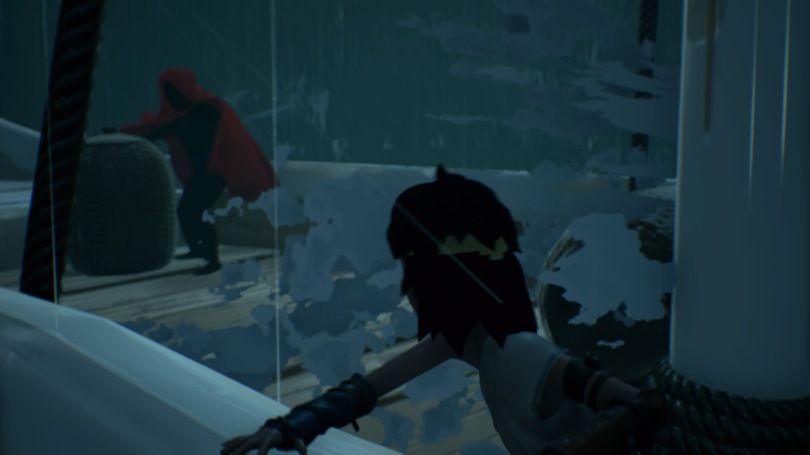
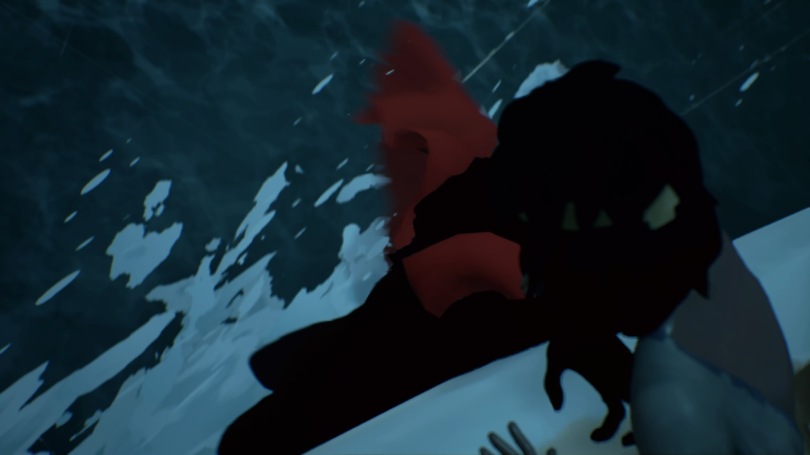
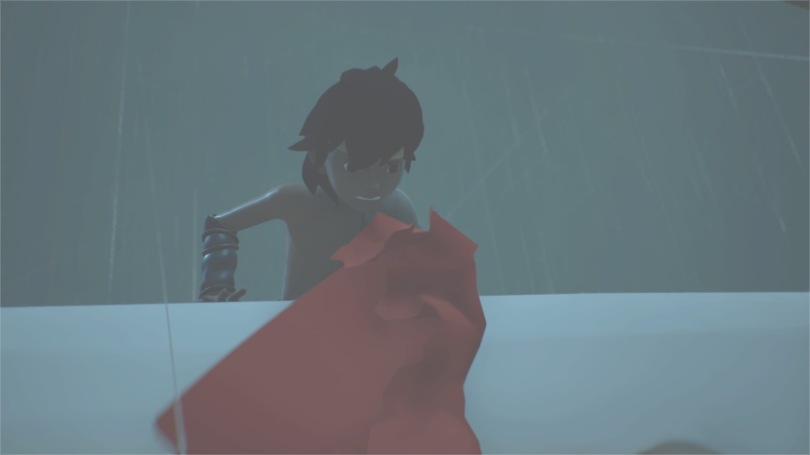
So the boy lost the adult with him. At least he has his fox and his robots, though.
Then, one by one, the robots sacrifice themselves to open the path forward for the boy, until the leader of the group – and the one closest to a friend of them all, steps forward to sacrifice himself as the boy pleads with him to stay behind. The robot hesitates, watching the boy kneeling on the ground, bargaining, before taking the final step and opening the door into… depression.

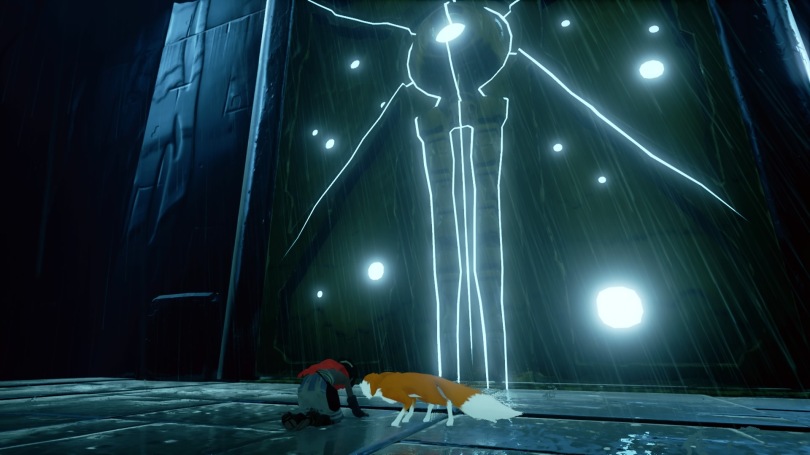
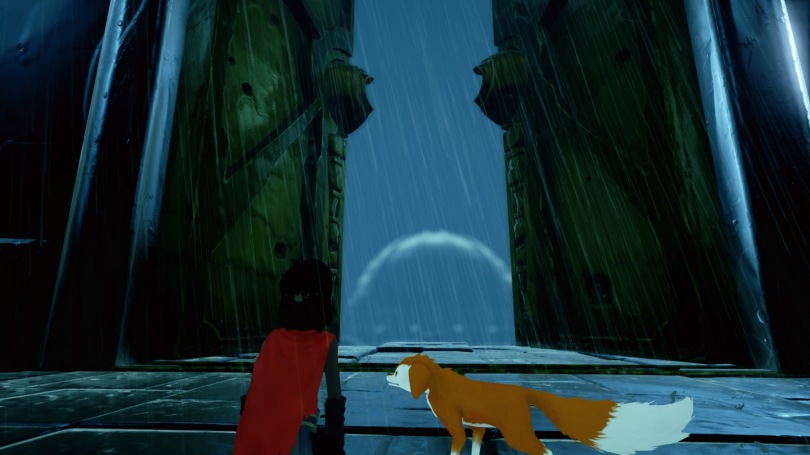
I’m not sure what I can say about this stage, other than comment that, for once, our fox friend is by our hero’s side, trying to help our hero solve the puzzles.
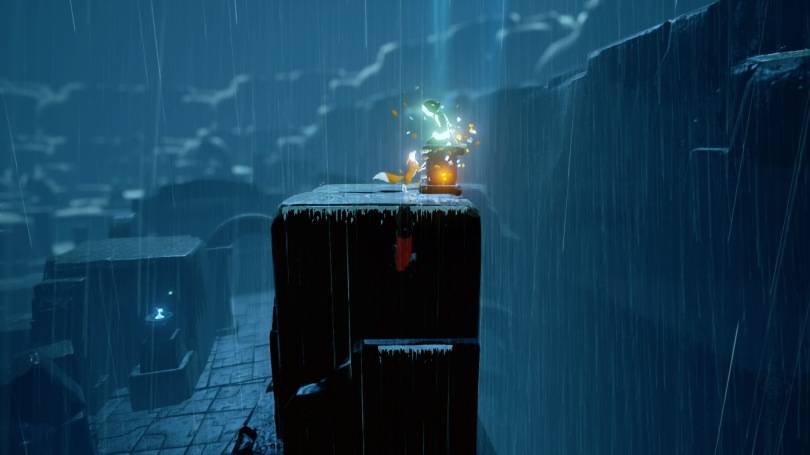
Although for the first time, the little fox seems to tire…
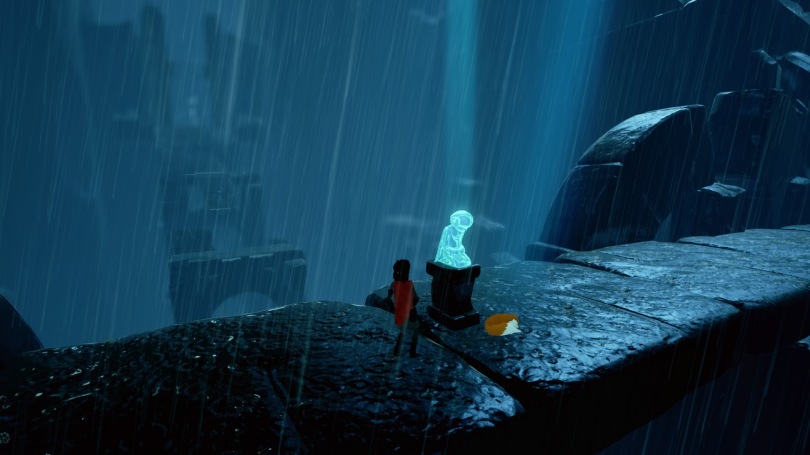
And then, once all the puzzles were solved…

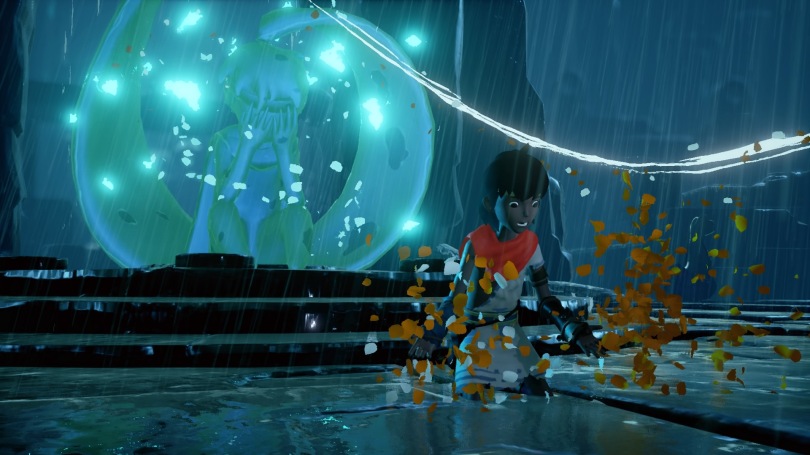
…and the boy cracks, screaming and turning to stone in his grief. In the final moments of the game, after having lost so much else, the boy finally loses everything he has left.
When the boy finally presses on, we see that he no longer looks like the young boy, but rather like one of the specters we’ve been encountering. We follow the boy, solving puzzles, until eventually, something horrible happens.

We are forced to see a familiar cutscene, but this time, it’s not a cloaked figure that is thrown overboard. It’s a little boy in a red raincoat. And it’s not a boy doing the saving, it’s his father.
In one moment, the game forces the player to quickly go through the stages of grief. In recognizing the cutscene, but now with an older man as the “playable character” and not the boy, the player is thrown into denial (“no way…”).
The player might skip over bargaining, knowing that the game is going to play how it will play, but maybe they still hope for a miracle that the father will somehow save the boy the player had befriended.
Followed by sadness as they see the little boy washed out to sea, his rain jacket ripping off in his father’s hands.

What follows next is beautifully done. The boy awakens much like he did on the beach, but now he is lying on his bed in his home by the sea. He wanders down the hall to find his father, sitting unmoving and as stone, the way the boy had been in his deepest grief. As the boy watches, his father and his home fade away to reveal a deep tunnel into the ground. The only way to move is forward, and the boy, after a moment’s hesitation, jumps down, falling up into the sky…


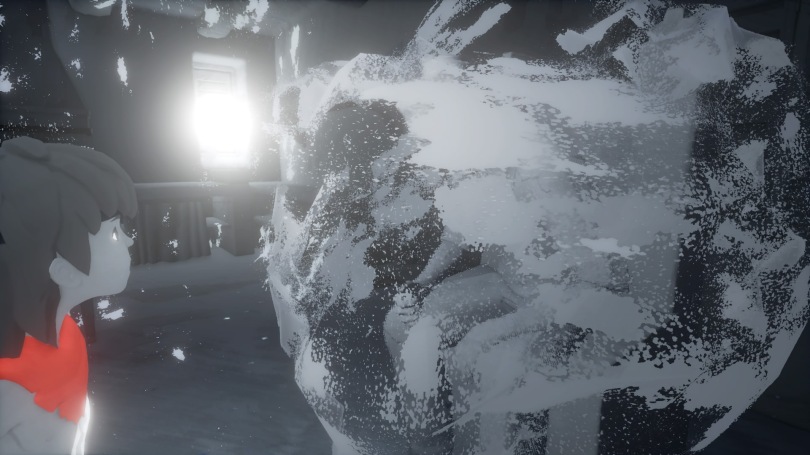
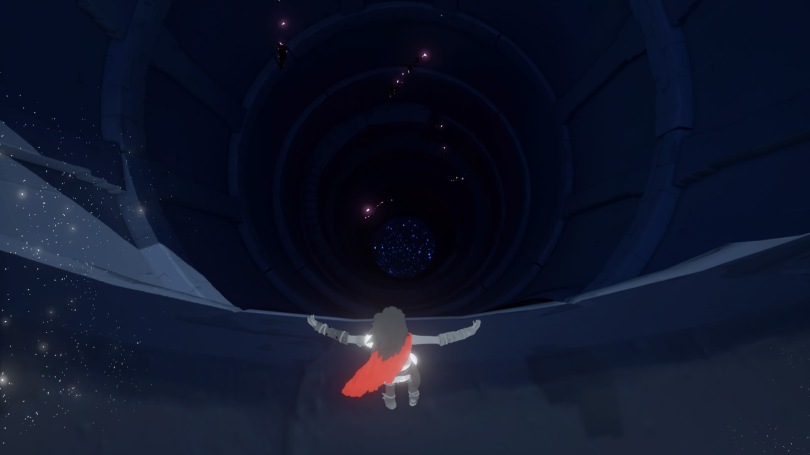
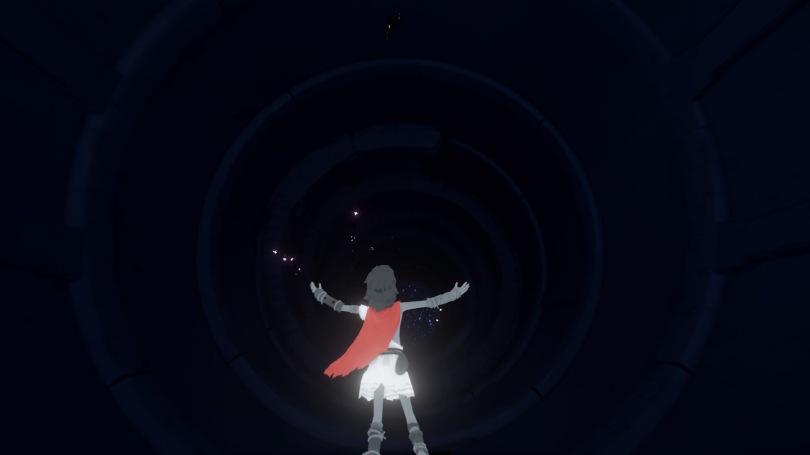
…that shines through the window on his father’s shoulder.
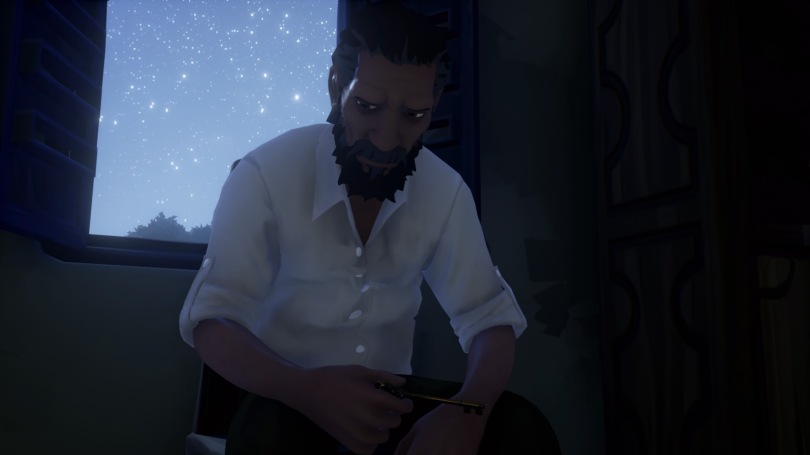
The father, then, makes his way down the hall to his son’s old room and…
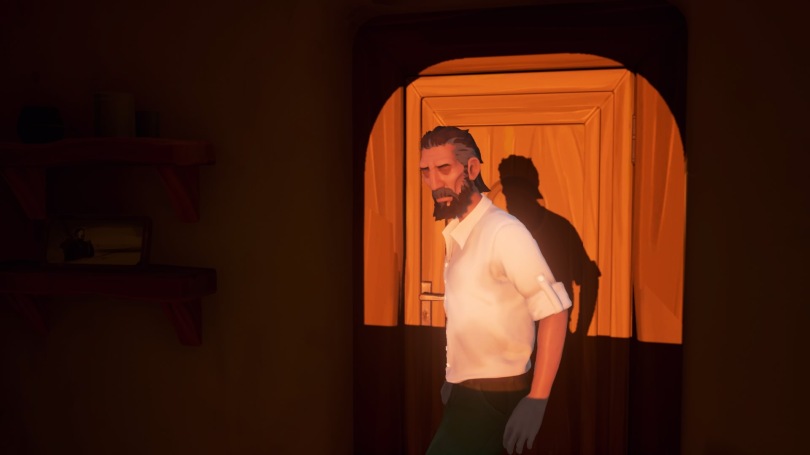
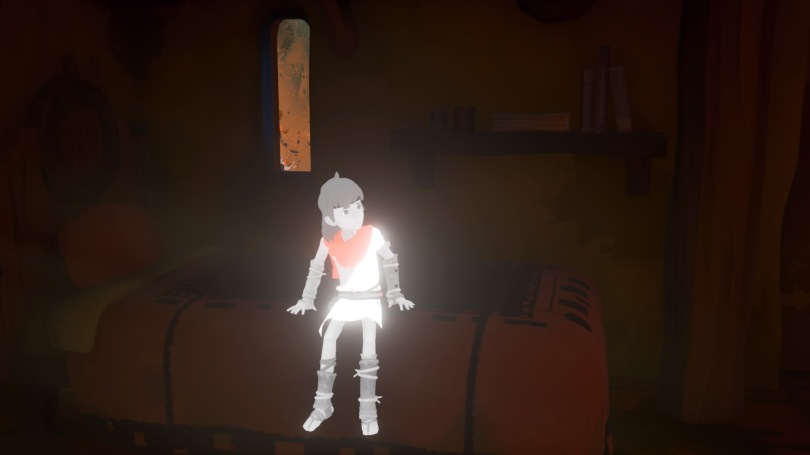
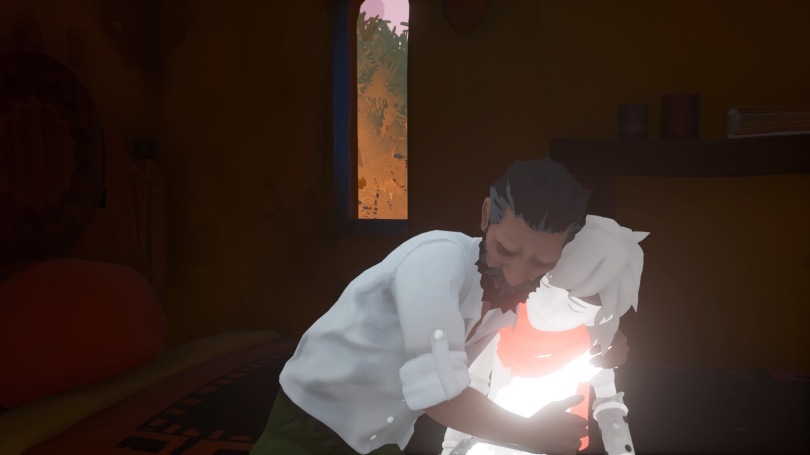
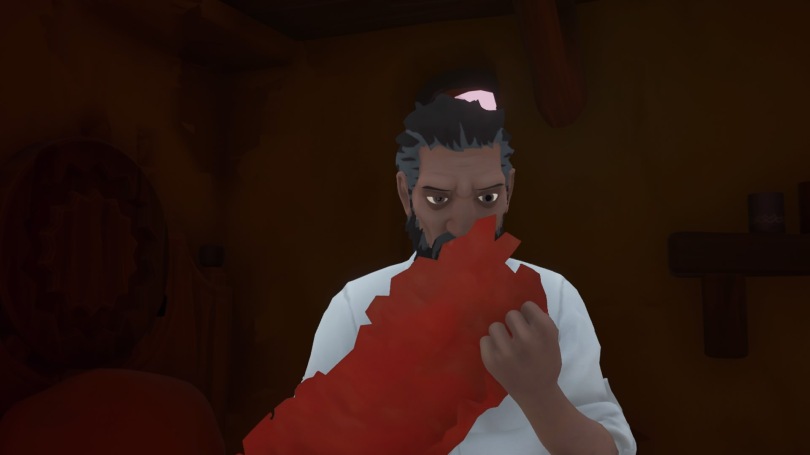

…lets go.
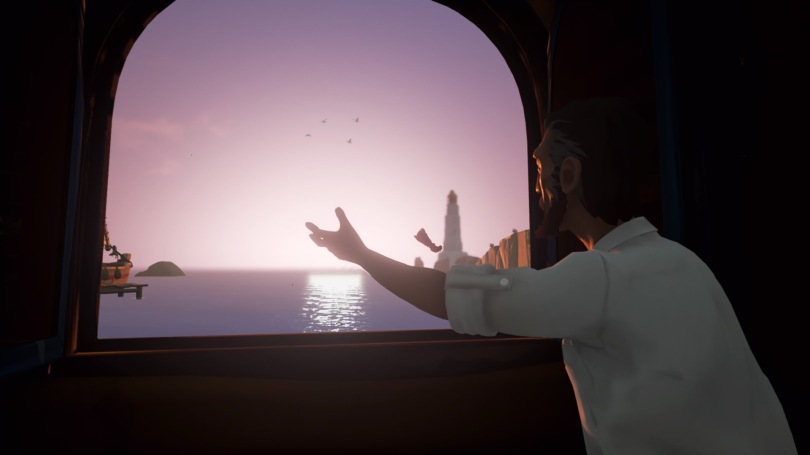

Final Thoughts
So who was this game about? Were we helping a little boy come to terms with his own fate, or were we merely the imaginings of a grieving father trying to grapple the loss of his son? Or, perhaps, was it a journey both of them underwent simultaneously in their own ways, before finally accepting the fate that befell them?
Oh, and I should mention… That door-like hole at the top of the tower (below) looks like a keyhole, doesn’t it? It might fit the key the father holds. And how interesting that as the boy accepts his fate, the tower inverts, as if unlocked, just like how the father unlocks the boy’s bedroom door…

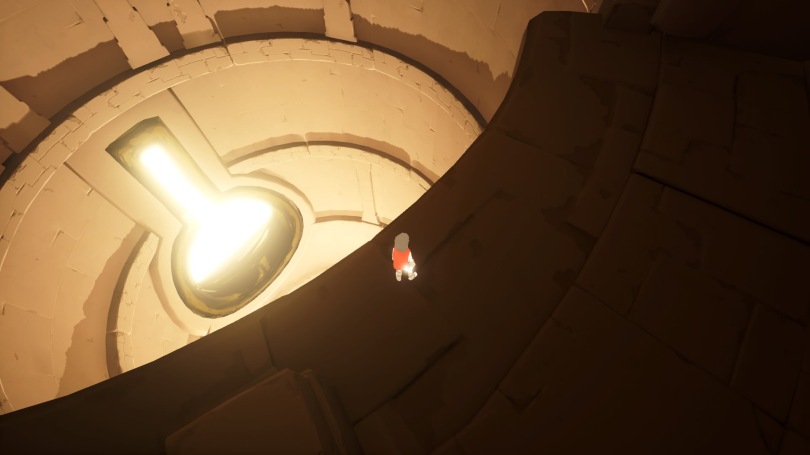
But maybe it doesn’t matter, because what does matter is that RiME captures the complexities of grieving in a beautiful game that truly pulls on a player’s heart and, instead of allowing them the safe, objective distance at which they can observe an emotion, gives them a reason to experience a similar to grief to the father, watching a boy they have protected and cared for be unexpectedly taken away from them.
Thankfully, even these emotions can be experienced from a safe distance, allowing the player to truly examine the stages of grief without really having lost anything.
I loved the amount of symbolism in this game, and half the fun at the end was trying to figure out what it all was: who were the mechanical sentinels? Why was the boy’s guide a fox? Was it surprising to think that the boy saw his father as a king the entire game? Why was it a black cloud that protected the boy from the bird? Why did the specters hurt the boy sometimes, and not others?
I have my own ideas as to the answer to these questions, but I will leave them for you to ponder as you play through Tequila Game’s beautiful creation. It would truly be a loss for that to be taken away from you.
Have you played RiME? What did you think of it? What do you think the story was about? Let me know in the comments!
Thanks for stopping by, and I’ll see you soon!
~ Athena
**Extra content available on this topic on Patreon!**
What’s next? You can like, subscribe, and support if you like what you’ve seen!
– Support us on Patreon, become a revered Aegis of AmbiGaming, and access extra content!
– Say hello on Facebook, Twitter, and even Google+!
– Check out our Let’s Plays if you’re really adventurous!


I very much appreciated the big spoiler warning and skipped that section. You already sold me on the game and what I read of your superb review makes me wanna play it even more now!! That fox is so adorable, haha. It’s also nice when a game let’s you figure out things on your own, in a forgiving way. Navi forcefully telling me how to open a damn door in the Deku Tree is always my go-to example of how hand-holding in games can get ridiculously annoying sometimes, haha.
I’ll be back to read the rest of this sometime after Nov 14th when the Switch version is out! Also your Patreon notes totally blew my mind about Super Mario Bros. Well done, as always! 😀
LikeLiked by 1 person
I’m trying to be better in my reviews about marking spoilers, especially with games that are new-ish. Can’t wait to see what you think of it!
Poor Navi – I wish there was an option for “I played this game before, please stop.” She was pretty helpful the first time around! haha But you’re right. That is hand-holding at possibly its worst!
LikeLiked by 1 person
I beat RiME recently, I’m back, and I’ve now read the spoiler section! 🙂 It was a really good read and gave me some more things to think about. Great work. I’m still pondering what the fox represented. This game certainly left me with a lot of feelz, too. It was a sad but beautiful experience that’s really hard to put into words, honestly.
I also wish there was some merchandise for this game, like a fox Amiibo or something, haha.
LikeLiked by 1 person
I read you write-up. I’m so happy you had such a memorable experience with it! I think the fox is left up for interpretation: is he/she a spirit guide? a representation of the boy or his life? his father? The possibilities are endless!
LikeLiked by 1 person
Thank you for reading my post about it! Games that leave us thinking about them long after the credits roll really are the best experiences 😀
LikeLiked by 1 person
I’d have to agree, I appreciate the big giant spoiler warning as well. I’ve had this game on my list since I first caught wind of its soundtrack, but as always, I’m gonna wait until I can get it for like 75% off.
I am a little worried about having no real control guide, though. That’s not a problem for me on console, but playing on computer, that’d leave me with a whole mess of buttons to try and figure out. An easily solvable problem, but one to consider.
LikeLiked by 1 person
I’ve gone back and forth over whether to get this game or not but I think this has sold me on getting it (when I can justify buying it at least!). I skipped all the spoiler section so I can enjoy it myself when I play so appreciate the spoiler alerts.
LikeLiked by 1 person
Yes! I recommend it. It was really very beautiful.
When you finish it, I hope you come back and let me know what you thought of it!
LikeLike
Thanks for marking spoilers! I’m currently playing through RiMe and I’d hate to be spoiled, especially since a huge part of the game is indeed learning to game, as you said! That said, I agree with the pre-spoiler section. I like the environmental puzzle exploration of the game, and that fruit tree example stuck out to me too. I just go to the part with the bird, so I don’t think I’m that far yet, but I like what I’ve experienced. And a button to sing and scream is perfect. I need that in my life haha.
LikeLiked by 1 person
You’re playing RiME? Yay! haha And you’re right that a button to sing and scream would come in very handy in the real world haha
Ooo yeah that bird is just… just awful. I hope when you finish it you’ll let me know what you thought the it 🙂
LikeLiked by 1 person
Yes!!! I’m playing the Switch version! So far I’m enjoying the puzzles and the world, but the frame rate seems so slow, at least on Switch, so everything stutters. It’s such a shame because the game looks so wonderful, otherwise! I will definitely let you know what I think afterwards! 🙂
LikeLiked by 1 person